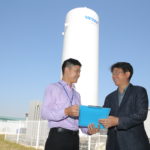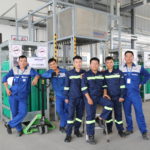With a diversified industrial gases portfolio, Messer expects to meet all of the gas needs of customers.
Ar
Most common noble gas on Earth; about 0.93 % share of the atmosphere
-186 °C
-189 °C
Air separation
Colorless, odorless noble gas, monatomic and extremely inert,
heavier than air, nonflammable
Argon is used as a shielding gas for welding and also used to degas metal melts. It serves as a filling gas in light bulbs, as lighting gas for gas discharge lamps, and as a laser medium in argon-ion lasers. It is used as a filler gas in insulating glass panes and for protection against oxidation in the food and beverage industry. Argon can even be used as a gaseous solvent.
A human inhales and exhales a full 120 liters of argon daily, because its nearly 1% share of atmospheric air makes it the third largest constituent after oxygen and nitrogen – one liter of air contains about 9.3 milliliters of argon. In outer space, argon is the third most common element after helium and neon. On Earth, it is the most common of the seven noble gases.
By far the largest share of argon on Earth is in the air. Because argon is also created by the decomposition of the potassium isotope 40K in the Earth’s crust, small quantities of it exist in rock. From volcanoes and hot springs, the noble gas also escapes into seawater and groundwater.
It was the second noble gas (after helium) to be described scientifically. British chemists William Ramsay and William Rayleigh discovered it in 1894 while studying the composition of air. Because the gas – like all noble gases – proved to be extremely inert, the scientists named argon after the ancient Greek word “aergon,” which means “lazy” or “inactive.” To this day, only one chemical compound of argon is known: argon fluorohydride (HArF). Stable only at extremely low temperatures, its existence was proven by Finnish scientists in 2000.
Argon in nonflammable, heavier than air and undergoes practically no chemical reactions. Most industrially produced argon is used as shielding gas for welding and in metallurgy – in the production of steel, pure silicon or titanium, for example. It is used as a solvent in automatic fire extinguisher systems and, in a mixture with helium, ensures that airbags inflate instantaneously in an emergency. Its low thermal conductivity makes the noble gas a good choice as a filling gas for the interstitial space in double glazed windows. It is also used in winemaking for transfer pumping and as gas filling in barrels to protect wine from oxidation. Argon is also used as filling gas for light bulbs and as lighting gas for gas discharge lamps. In the latter, it produces the typical violet color.
Do you have questions regarding Messer products, services and technology applications?
We are always ready to support




